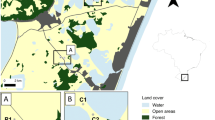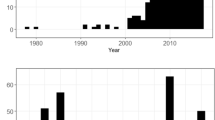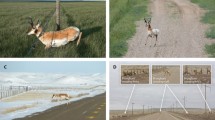Abstract
We are using bobcats (Lynx rufus) as a model organism to examine how roads affect the abundance, distribution, and genetic structure of a wide-ranging carnivore. First, we compared the distribution of bobcat-vehicle collisions to road density and then estimated collision probabilities for specific landscapes using a moving window with road-specific traffic volume. Next, we obtained incidental observations of bobcats from the public, camera-trap detections, and locations of bobcats equipped with GPS collars to examine habitat selection. These data were used to generate a cost-surface map to investigate potential barrier effects of roads. Finally, we have begun an examination of genetic structure of bobcat populations in relation to major road networks. Distribution of vehicle-killed bobcats was correlated with road density, especially state and interstate highways. Collision models suggested that some regions may function as demographic sinks. Simulated movements in the context of the cost-surface map indicated that some major roads may be barriers. These patterns were supported by the genetic structure of bobcats. The sharpest divisions among genetically distinct demes occurred along natural barriers (mountains and large lakes) and in road-dense regions. In conclusion, our study has demonstrated the utility of using bobcats as a model organism to understand the variety of threats that roads pose to a wide-ranging species. Bobcats may also be useful as one of a group of focal species while developing approaches to maintain existing connectivity or mitigate the negative effects of roads.





Similar content being viewed by others
References
Aresco MJ (2005) Mitigation measures to reduce highway mortality of turtles and other herpetofauna at a north Florida lake. J Wildl Manag 69:549–560
Balkenhol N, Holbrook JD, Onorato D, Zager P, White C, Waits LP (2014) A multi-method approach for analyzing hierarchical genetic structures: a case study with cougars Puma concolor. Ecography 37:552–563
Bani L, Baietto M, Bottoni L, Massa R (2002) The use of focal species in designing a habitat network for a lowland area of Lombardy, Italy. Conserv Biol 16:826–831
Beckman JP, Clevenger AP, Huijser MP, Hilty JA (eds) (2010) Safe passages – highways, wildlife, and habitat connectivity. Island Press, Washington, DC
Beier P, Majka D, Bayless T (2007) Linkage designs for Arizona. Corridor Design. http://www.corridordesign.org/linkages/arizona. Accessed 15 Oct 2014
Beier P, Majka DR, Spencer WB (2008) Forks in the road: choices in procedures for designing wildland linkages. Conserv Biol 22:836–851
Bissonette JA, Rosa SA (2009) Road zone effects in small-mammal communities. Ecol Soc 14:27. http://www.ecologyandsociety.org/vol14/iss1/art27/. Accessed 15 Oct 2014
Breckheimer I, Haddad NM, Morris WF, Trainor AM, Fields WR, Jobe RT, Hudgens BR, Moody A, Walters JR (2014) Defining and evaluating the umbrella species concept for conserving and restoring landscape connectivity. Conserv Biol 28:In press
Broman DJA (2012) A comparison of bobcat habitat suitability models derived from radio telemetry and incidental observations. M. S. Thesis, University of New Hampshire, Durham
Broman DJA, Litvaitis JA, Ellingwood M, Tate P, Reed G (2014) Modeling bobcat distributions using incidental observations and telemetry locations: are the results comparable? Wildl Biol 20:229–237
Cain AT, Tuovila VR, Hewitt DG, Tewes ME (2003) Effects of a highway and mitigation projects on bobcats in Southern Texas. Biol Conserv 114:189–197
Carmichael LE, Clark W, Strobeck C (2000) Development and characterization of microsatellite loci from lynx (Lynx canadensis), and their use in other felids. Mol Ecol 9:2155–2234
Carroll C, Noss RF, Paquet PC (2001) Carnivores as focal species for conservation planning in the rocky mountain region. Ecol Appl 11:961–980
Crooks KR (2002) Relative sensitivities of mammalian carnivores to habitat fragmentation. Conserv Biol 16:488–502
Crooks KR, Sanjayan MA (eds) (2006) Connectivity conservation. Cambridge University Press, Cambridge
Cushman SA, Landguth EL (2012) Multi-taxa population connectivity in the Northern Rocky Mountains. Ecol Model 231:101–112
Fahrig L (2002) Animal populations and roads. In: Evink GL, Garret P, Zeigler D (eds) Proceedings of the International Conference on Ecology and Transportation and the Environment. The Center for Transportation and the Environment at North Carolina State University, Raleigh, pp 9–11
Fahrig L, Rytwinski T (2009) Effects of roads on animal abundance: an empirical review and synthesis. Ecol Soc 14: 21. http://www.ecologyandsociety.org/vol14/iss1/art21/. Accessed 15 October 2014
Faircloth BC, Reid A, Valentine T, Eo SH, Terhune TM, Glenn TC, Palmer WE, Nairn CJ, Carroll JP (2005) Tetranucleotide, trinucleotide, and dinucleotide loci from the bobcat (Lynx rufus). Mol Ecol Notes 5:387–389
Fenderson LE, Kovach AI, Litvaitis JA, O’Brien K, Boland K, Jakubas W (2014) Genetic structure and connectivity of the New England cottontail (Sylvilagus transitionalis) in a highly-fragmented landscape. Ecol Evol 4:1853–1875
Forman RTT, Reineking B, Hersperger AM (2002) Road traffic and nearby grassland bird patterns in a suburbanizing landscape. Environ Manag 29:782–800
Forman RTT, Sperling D, Bissonette JA, Clevenger AP, Cutshal CC, Dale VH, Fahrig L, France R, Goldman CR, Heanue K, Jones JA, Swanson WJ, Turrentine T, Winter TC (2003) Road ecology: science and solutions. Island Press, Washington, DC
Fry J, Xian G, Jin S, Dewitz J, Homer C, Yang L, Barnes C, Herold N, Wickham J (2011) Completion of the 2006 National Land Cover Database for the conterminous United States. Photo Eng Remote Sens 77:858–864
Gibbs JP, Shriver G (2002) Estimating the effects of road mortality on turtle populations. Conserv Biol 16:1647–1652
Guillot G, Mortier F, Estoup A (2005) Geneland: a computer package for landscape genetics. Mol Ecol Notes 5:712–715
Hels T, Buchwald E (2001) The effects of road kills on amphibian populations. Biol Conserv 99:331–340
Jansen D, Sherwood K, Fleming E (2010) The I-75 project: lessons from the Florida panther. In: Beckman JP, Clevenger AP, Huijser MP, Hilty JA (eds) Safe passages – highways, wildlife, and habitat connectivity. Island Press, Washington, DC, pp 205–222
Johnson DH (1980) The comparison of usage and availability measurements for evaluating resource preference. Ecology 61:65–71
Johnson CJ, Seip DR, Boyce MS (2004) A quantitative approach to conservation planning: using resource selection functions to map the distribution of mountain caribou at multiple spatial scales. J Appl Ecol 41:238–251
Justice D, Deely A, Rubin F (2002) New Hampshire land cover assessment. Complex Systems Research Center, Durham
Koen EL, Garroway CJ, Wilson PJ, Bowman J (2010) The effect of map boundary on estimates of landscape resistance to animal movement. PloS One 5:e11785
Lambeck RJ (1997) Focal species: a multi-species umbrella for nature conservation. Conserv Biol 11:849–856
Lele SR, Keim JL, Solymos P (2013) ResourceSelection: Resource selection (probability) functions for use-availability data. R package version 0.2-2. http://CRAN.R-project.org/package=ResourceSelection. Accessed 1 Oct 2013
Litvaitis JA (1993) Response of early successional vertebrates to historic changes in land use. Conserv Biol 7:866–873
Litvaitis JA, Tash JP (2008) An approach towards understanding wildlife-vehicle collisions. Environ Manag 42:688–697
Litvaitis JA, Clark AG, Hunt JH (1986) Prey selection and fat deposits of bobcats (Felis rufus) during autumn and winter in Maine. J Mammal 67:389–392
Litvaitis JA, Tash JP, Stevens CL (2006) The rise and fall of bobcat populations in New Hampshire: relevance of historical harvests to understanding current patterns of abundance and distribution. Biol Conserv 128:517–528
Mantel N (1967) The detection of disease clustering and a generalized regression approach. Cancer Res 27:209–220
McRae BH, Beier P (2007) Circuit theory predicts gene flow in plant and animal populations. Proc Natl Acad Sci 104:19885–19890
McRae BH, Shah VB (2009) Circuitscape user’s guide. University of California, Santa Barbara
Menotti-Raymond M, David VA, Lyons LA, Schaffer AA, Tomlin JF, Hutton MK, O’Brien SJ (1999) A genetic linkage map of microsatellites in the domestic cat (Felis catus). Genomics 57:9–23
Menotti-Raymond MA, David VA, Wachter LL, Butler JM, O’Brien SJ (2005) An STR forensic typing system for genetic individualization of domestic cat (Felis catus) samples. J Forensic Sci 50:1061–1070
Pritchard JK, Stephens M, Donnelly P (2000) Inference of population structure using multilocus genotype data. Genetics 155:945–959
R Core Team. (2012). R: A language and environment for statistical computing. R Foundation for Statistical Computing, Vienna, Austria. ISBN 3-900051-07-0, URL http://www.R-project.org/
Raymond M, Rousset F (1995) Genepop (version 1.2): population genetics software for exact tests and ecumenicism. J Hered 86:248–249
Reed GC (2013) Bobcats in New Hampshire: understanding the relationships between habitat suitability, connectivity and abundance in a changing landscape. MS Thesis, University of New Hampshire, Durham
Riley SPD, Pollinger JP, Sauvajot RM, York EC, Bromley C, Fuller TK, Wayne RK (2006) A southern California freeway is a physical and social barrier to gene flow in carnivores. Mol Ecol 15:1733–1741
Roberge J, Angelstam P (2004) Usefulness of the umbrella species concept as a conservation tool. Conserv Biol 18:76–85
Roberts NM, Crimmins SM (2010) Bobcat population status and management in North America: evidence of large-scale population increase. J Fish Wildl Manag 1:169–174
Rousset F (2000) Genetic differentiation between individuals. J Environ Biol 13:58–62
Sappington JM, Longshore KM, Thompson DB (2007) Quantifying landscape ruggedness for animal habitat analysis: a case study using bighorn sheep in the Mojave Desert. J Wildl Manag 71:1419–1426
Sergio F, Newton I, Marches L (2005) Top predators and biodiversity. Nature 436:192
Simmons JM, Sunnucks P, Taylor AC, van der Ree R (2010) Beyond roadkill, radiotracking, recapture and FST—a review of some genetic methods to improve understanding of the influence of roads on wildlife. Ecol Society 15(1): 9. http://www.ecologyandsociety.org/vol15/iss1/art9/. Accessed 15 Oct 2014
Singleton PH, Gaines WL, Lehmkuhl JF (2002) Landscape permeability for large carnivores in Washington: a geographic information system weighted-distance and least-cost corridor assessment. Research Paper PNW-RP-549. US Forest Service Pacific Northwest Research Station, Portland, Oregon
Sirén APK (2015) A comparison of snow track and camera surveys for detecting Canada lynx (Lynx canadensis) and sympatric carnivores in north-central New England. Final Report, New Hampshire Fish and Game Department, Concord
Sundquist D, Hewes J (2010) Population growth and land use change in the Granite State. The Society for the Protection of New Hampshire Forests. Concord, New Hampshire. Web. http://www.forestsociety.org/. Accessed 25 Feb 2012.
The Nature Conservancy (2013) Staying connected in the northern Appalachians: mitigating fragmentation and climate change impacts on wildlife through functional habitat linkages. Final report submitted to the New Hampshire Fish and Game Department and the United States Fish and Wildlife Service. http://stayingconnectedinitiative.org/assets/SCI-CSWG-Final-Report-Summary-5-17-13. Accessed 15 Oct 2014
Thorne JH, Cameron D, Quinn JF (2006) A conservation design for the central coast of California and the evaluation of mountain lion as an umbrella species. Nat Areas J 26:137–148
van Langevelde F, Jaarsma CF (2004) Using traffic flow theory to model traffic mortality in mammals. Landsc Ecol 19:895–907
van Oosterhout C, Hutchinson WF, Wills DPM, Shipley P (2004) Micro-checker: software for identifying and correcting genotyping errors in microsatellite data. Mol Ecol Notes 4:535–538
Wright S (1943) Isolation by distance. Genetics 31:114–138
Acknowledgments
This project was funded in part, by Wildlife Restoration Program grant W-90-R-1 in cooperation with the United States Fish and Wildlife Service, Wildlife and Sport Fish Restoration Program. Partial funding was provided by the New Hampshire Agricultural Experiment Station. This is Scientific Contribution Number 2599. This work is supported by the USDA National Institute of Food and Agriculture, McIntire-Stennis Project 233076. We thank many students at UNH for assistance in all phases of this project. Light Hawk Flight Services provided aerial support. J. Arrow, D. Hockman, M. Kazak, R. McMasters, M. Morrison, and A. Whipple captured bobcats for our telemetry study.
Author information
Authors and Affiliations
Corresponding author
Rights and permissions
About this article
Cite this article
Litvaitis, J.A., Reed, G.C., Carroll, R.P. et al. Bobcats (Lynx rufus) as a Model Organism to Investigate the Effects of Roads on Wide-Ranging Carnivores. Environmental Management 55, 1366–1376 (2015). https://doi.org/10.1007/s00267-015-0468-2
Received:
Accepted:
Published:
Issue Date:
DOI: https://doi.org/10.1007/s00267-015-0468-2




